DAMN-PING OFF
Worse than Roman Warriors
I made my first gardening enemies decades ago, within a few weeks of starting my first garden. Not other gardeners but — and perhaps you also have crossed paths with them — with Pythium, Rhizoctonia, and Fusarium. I quickly learned that they were, or should be, hateful not only to me but to all gardeners.
Pythium, Rhizoctonia, and Fusarium are not ancient Roman warriors; they are fungi and, worse than Roman warriors, they lurk everywhere. When they, or one of them, gets the upper hand they cause damping off disease.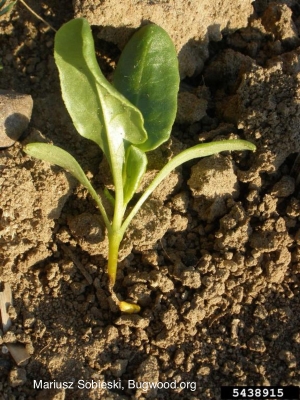
Let’s return to my first garden: At the time, decades ago, I was living in a relatively dark apartment, a converted motel room, and was eager to start my first seedlings. I sowed all sorts of seeds in peat pots, stood them in a little water, then crowded them together on all the shelf space that could be mustered.
Young sprouts never appeared in some of the pots. In others, seedlings emerged, then toppled over, their “ankles” reduced to a withered string of rotted cells unable to support the small plants physically or physiologically.
It didn’t take much research to determine that damping off disease had entered my gardening world. I learned that damping off disease can even attack before seedlings emerge. With such a brutal introduction to gardening and damping-off disease, it’s a wonder I didn’t give up this bucolic activity right then and there.
As I wrote above, the “Roman warriors” lurk everywhere. The usual recommendation, among other measures, is to avoid damping off by thoroughly washing tools, seedling containers, and seed flats, and by using sterilized potting soil, and not re-using it. Even, if need be, using fungicide-treated seeds or, worst case scenario, applying an approved fungicide.
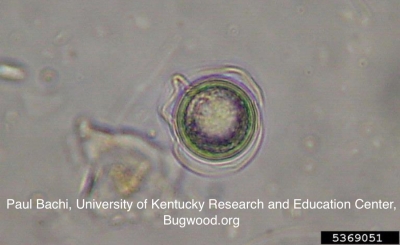
Pythium damping off spore
Multipronged Control
Let’s back off with the chemicals: The fungi that cause damping-off occur naturally in most soils, preferring live plants but feeding on dead plant material when nothing alive is available. These fungi cause problems only when a suitable environment and food supply allow their populations to soar. Seedling stems rot away right at the soil line, which is why they dramatically topple over. When seeds are attacked, they rot before even germinating — a less dramatic but no less destructive result. The fungi that are responsible for damping off aren’t finicky in their food preferences, attacking apple seedlings as readily as those of tomato or zinnia.
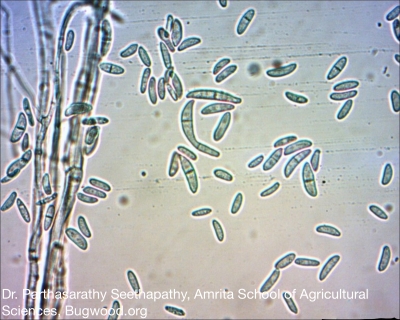
Fusarium damping off
Soon after that early wake-up call, I learned to control damping off and can count on one hand the number of times my seedlings have succumbed in past decades. My approach is multipronged, a striving to provide the best possible conditions for seedlings and the worst possible conditions for the fungi.
First, starve the fungi. Damping-off fungi can survive on fresh plant remains. I use compost in my potting mix — a no-no according to most experts — but only well-ripened compost in which all traces of original plants are long gone. In addition to providing nutrients and helping with aeration and moisture retention of a potting mix, compost is also home to myriad microorganisms that fight off Pythium, Rhizoctonia, and Fusarium.
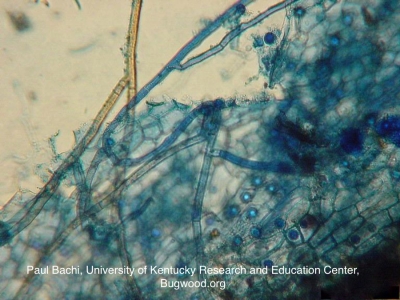
Rhizoctonia damping off
Damping off fungi also enjoy waterlogged soil. That’s why, in addition to compost, I add 1/4 by volume perlite to my potting mixes. Vermiculite, calcined montmorillonite clay (kitty litter, some types), or coarse sand could also help speed water through the mix.
I avoid planting seeds that have lowered vitality either due to improper or extended storage.
For an extra preventative, I used to cover the surface of the soil after sowing with a thin layer of some material such as sand or perlite to keep stems dry at the soil surface. Even better would have have been a thin layer of shredded sphagnum moss, which not only keeps the surface dry, but also is inherently fungistatic. I no longer bother with that either.
After planting, I keep containers warm enough so seeds germinate rapidly. Watering with chamomile tea reputedly prevents damping-off. It’s another measure I don’t bother with.
Good Culture
Once seedlings poke through the soil surface, they get moved to where they can bathe in abundant light and moving air — both conditions of which were lacking with my first seedlings way back when. I further promote air circulation by thinning excess seedlings so there is adequate space between them.
I’m careful not to overwater. Mostly I water from below unless it’s a sunny day which will quickly dry the surface of the potting mix. When I used to start seedlings under lights, I would carefully water the surface of the potting soil rather than drenching plants and soil.
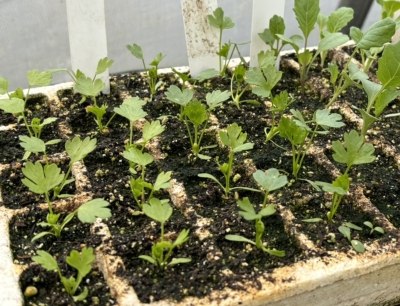
Healthy seedlings, capillary mat watering from below
Notice that I have not mentioned anything about using fungicides or sterilized potting soil. Fungicides are poisonous. Using them can upset natural balances and, anyway, using them saps some of the fun out of gardening.
Even a sterilized potting mix is not without its drawbacks. Temperatures that soar too high can kill off the beneficial fungi that fend off disease-causing fungi. High temperatures also cause a release of excessive nitrogen, which damping off fungi like, and manganese, a plant micronutrient that becomes toxic in excess. After a mix is sterilized, harmful organisms can reinvade, unchecked by natural antagonists.
My home made mix contains real soil, and that is the only portion I heat up, doing so enough to kill weed seeds.
Not that I recommend following my lead, but I admit to rinsing a used container or seedling flat before using it — or not — but forego any scrubbing, soapy water, or Chlorox.
In my experience, good “culture” — good soil and careful attention to temperature, water, and light — makes the use of fungicides or sterile soil unnecessary. And good soil and careful attention to temperature, water, and light are earmarks of good gardening, anyway.
Note: For more cool and useful information about some microbial enemies in gardening and how to deal with them, see my book The Ever Curious Gardener: Using a Little Natural Science for a Much Better Garden, available from the usual sources or, signed by me, from www.leereich.com/books.


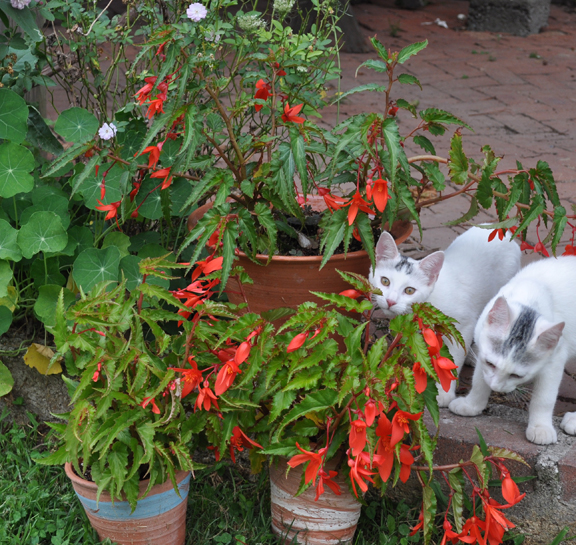
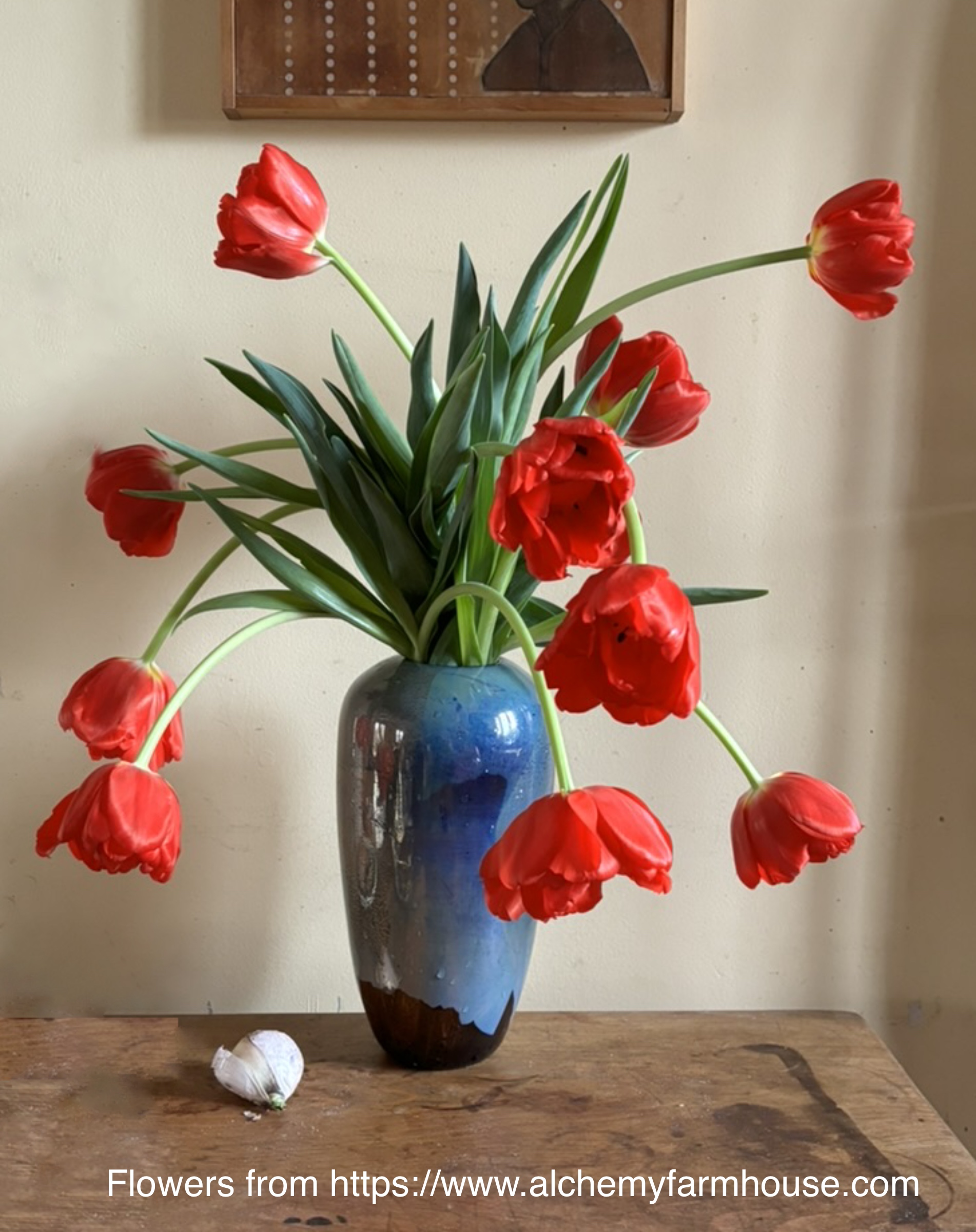
Leave a Reply
Want to join the discussion?Feel free to contribute!